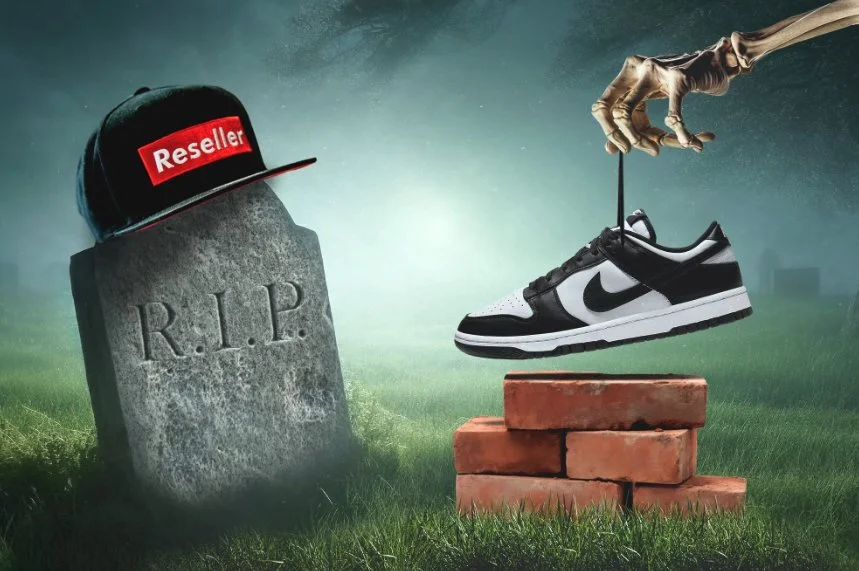Rethinking the Sneakersphere: An interview with Woody Wood
It’s not every day one gets an exclusive tête-à-tête with a world authority on sneakers. Following the popularity of our recent article about why sneakers and sportswear still lag on sustainability, I reached out to Simon ‘Woody’ Wood, Editor-in-Chief and founder of Sneaker Freaker magazine at his Melbourne HQ to dive deeper into some of the key challenges facing the sneaker industry.
A: Woody, for anyone who doesn’t already know, who or what is a sneakerhead and what are the values that motivate sneaker collecting?
W: Sneakerheads are obsessed with fiending over and accumulating ridiculous collections of vintage, retro and collectible footwear. That covers the hardcore, but in reality, anyone who has an abiding interest in Nike, New Balance and adidas etc. might also consider themselves a sneakerhead.
A: You’ve described Sneaker Freaker as the sneaker industry’s conscience and you seem to strike an effective balance between sustaining and critiquing it. More recently you’ve highlighted some of the problems associated with excessive hype, the resale market and wasteful production. How receptive are sneakerheads and the sneaker industry to these challenging conversations?
W: Yeah, that particular article ruffled a few feathers. Our global audience is very switched-on and they expect critical opinions from Sneaker Freaker. The issues I raised around hype and availability are ones that many of our followers have already experienced. We also have a huge audience that work in the industry and I’m always mindful of their perspectives. Hopefully some direct feedback from fans via SF gives the higher ups a few things to think about. Whether it has any influence, I’m not sure.
RIP Resellers… Why Greed and Monotony Are Killing the Game, Woody, Sneakerfreaker.com, 6th March 2024. Image courtesy of Sneaker Freaker.
A: In terms of environmental sustainability, footwear is a very challenging category, but sneakers perhaps pose the biggest problem due to their complex construction, adhesives, multiple and unsustainable materials and the difficulties they present for recycling. How effectively is the industry addressing these challenges or is it mainly tokenistic gestures and greenwashing? Any promising examples?
W: Veja is the first brand that comes to mind if you want a promising example. They do a great job of covering both the social and eco issues, though it’s not a brand coveted by proper sneakerheads.
Faced with endless greenwashing spin, I think we’ve all become so distrustful of chronic BS that what seems like a good news story at face value is now greeted, rightly, with scepticism. As a result, ’sustainability’ has become a loaded gun for many brands, who are fearful of it being turned back on them if they’re accused of hypocrisy or shady dealings. Nike caught some recent legal flak around their Space Hippie program. I’m not sure how that will play out, but it’s pertinent to note that a surprisingly high number of senior Nike roles across their environmental, social, and governance departments disappeared during the recent layoffs in April 2024.
That aside, I have some sympathy for the big brands and appreciate how hard it is to get a genuine ‘eco’ message across without sounding corny or self-aggrandising. The legal definitions in this space are really tough as well, so the language often sounds very tightly scripted and lawyer-driven. I do genuinely believe that brands are trying to do the right thing. Whether that’s the reduction of adhesives or the way materials are sourced, entire teams are trying to streamline every facet of production. They strive to shave a few cents off a single component, but they are also thinking laterally about things like making shoe boxes more efficient and minimising materials wastage. They might not be miraculous game-changer ideas individually but small incremental wins are the key to major progress.
One thing I am particularly sensitive to is when a highly-touted project of this type is designed in such a way that it can’t possibly contribute anything on a meaningful level. There’s no point trumpeting the fact a shoe ‘reuses 12 plastic bottles found on a beach in the Maldives’ if only 20 pairs of shoes are made in total. What does move the needle is when a brand makes a significant manufacturing change to a shoe that sells millions of pairs every year.
A: Footwear circularity means closing the loop with products made from reused materials that can themselves be reused, repaired and recycled again and again. How is the footwear industry progressing with recycling generally?
W: Recycling shoes properly is, as you mentioned, difficult and therefore costly. Hard-soled shoes and boots can be fixed over and over by cobblers, but sneakers, by their nature, are built light and disposable. Back in 2003, Nike produced an extreme running shoe called the Mayfly. Designed to last just 100kms, they came with a pre-paid satchel to send them back to Beaverton for recycling into Nike Grind. The Mayfly was a brilliant concept but I’m guessing not many pairs went on to live a second life.
Having visited the factories, I have learned a bit about how hard it is to recycle shoes. Our office meeting room floor is lined with a product made from 100 per cent recycled footwear. The entire shoe – suede, mesh, rubber and laces – was munched up. The speckled texture in the sheets looks interesting and the storytelling is great, but the product is yet to become commercially viable, though I have heard that quite a few local brands and stores are using it in their new fitouts, which is promising.
Image courtesy of Sneaker Freaker
A: Sneaker culture is a very material culture with wearers/collectors often forming emotional attachments to particular styles due to the stories they represent, the memories they hold and the way they feel or even smell. It’s often said that the most sustainable shoes are the ones you already own. I’m wondering if you think the repair and refurbishment services we are seeing could become a more sustainable and scalable business model within the sneaker industry?
W: I can’t deny the sneaker game is a pure form of hyper-materialism, one that prizes accumulation over rational consumption. When I started the magazine in 2002, if you had 100 pairs, that was a solid haul. Now it’s common for teens to have hundreds and hundreds of shoes sitting in closets – nearly all unworn! The money some kids have access to these days is nuts. Who are all these people paying $3000 for a pair of Dunks? I used to think it was beyond weird but it’s no longer all that shocking.
The only time refurbishment makes sense is the re-soling of culturally significant shoes. I recently worked with a collector who owns dozens of signed and game-worn Jordans, with a combined value well into the multi-millions. When the leather upper remains in decent condition but the sole is a bag of crumbs after years of exposure to humidity and oxygen, it makes sense to source a modern sole unit to replace the old one. The vintage pair is once again totally wearable and looks good on display.
Modifications like this normally destroy the value of any collectible item, but the re-soling of shoes will become more common in the years ahead. In the case of Jordans, the rubber sole construction on the Jordan 1 makes them pretty much indestructible, but every subsequent model will eventually disintegrate, it’s just a question of when. The midsole foam in the Jordan 2 is particularly vulnerable. It’s savvy business to keep shoes worth millions looking good, but the average pair of sneakers is chewed up pretty quick and either binned or given away. On that basis, I’m not sure refurbs will ever become a viable mainstream practice.
Image courtesy of Sneaker Freaker
A: You’ve said previously that money ruins everything, particularly when brands undermine the cultural authenticity of their sneakers by selling-out and burning-out (for example by over-collaborating). Which brands do you think have avoided this fate and how have they done it?
W: The explicit aim of the capitalist system is (obviously) growth at all costs. Since nearly every major sneaker brand is listed on a stock exchange and primarily owned by institutions and venture capital firms, the pressure to produce investor profits is ever present. Mass layoffs, price gouging, shameless profiteering and the manipulation of sales/deliveries to meet targets and enhance executive bonuses are just some of the tactics used by publicly-listed firms to improve an ailing stock price. That’s a cynic’s view. But there is one brand that has the freedom to do everything differently.
New Balance was purchased in the 1970s by Jim Davis and under his watch they have stayed true to their ‘fearlessly independent’ ethos. I have enormous admiration for the way they have resisted the pressure over the years to conform. Most famously, they are the only brand with shoe factories in the USA and UK. Kudos for that alone. They also make shoes in different widths, a godsend for anyone with wide feet. A few years back they launched ‘the Track’, an incredible sporting hub open for use by the local Boston community. No other brand would have invested hundreds of millions in a facility that does not enhance the bottom line. In my experience, New Balance have shown it is possible to make solid profits and be a brilliant corporate citizen, in all its forms.
Sneaker Freaker x New Balance 574 “Tassie Devil”, 2018. Image courtesy of Sneaker Freaker.
A: Do you think it is possible to achieve environmental, social and cultural sustainability while also maintaining economic growth?
W: As with the example of New Balance, I have no doubt all three can happily coexist with maintaining economic growth. To a large extent, that is already happening today at most brands. It’s just a question of compromise, which unavoidably comes back to money. Investors rightfully expect results and I'd say the majority would prefer bigger dividends over Earth-first factors, though that might be starting to change as shareholder activism and legislation puts pressure on boards to make change happen.
A: What do you think of the concepts of slow-fashion and de-growth? Are they possible in the sneaker industry and in what circumstances?
W: De-growth sounds philosophically interesting, but as I understand the term, the concept seems rooted in a 1950s vision of utopian socialism. The global economy is not rushing back to a collectivist mindset – far from it. You only need to look at how bazillionaire wealth exploded over the last few years.
Whether the sneaker game qualifies as slow- or fast-fashion, I’m not sure. Sneaker Freaker produces around 100 pieces of content across all our channels every day, which certainly creates the impression of speed when there is so much happening 24/7. But given the typical development timeframe for shoes is several years, you can argue that footwear is far from fast-fashion. I’m sure all brands would love to build a magical machine that could pump out shoes all day every day with minimal labour and components. Come to think of it, maybe that is where the push for slides and clogs came from?
A: Do you have any other thoughts about the barriers standing in the way of more ethical and sustainable sneaker production and consumption practices? What kinds of things do you think could help to encourage meaningful change?
W: Hmmm… I’m hopelessly and philosophically conflicted on this issue. The barriers to sustainable sneaker production are the same ones faced by society in general. Is it possible that we can all be truly happy with less of everything in life? I love how Patagonia is challenging this notion, but even then, it’s a slippery slope. Nobody needs 100 pairs of shoes but it seems there’s always room for one more.









